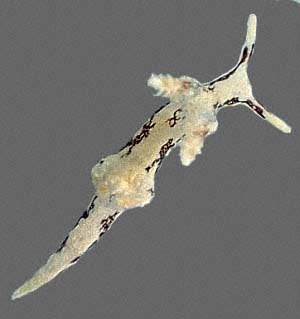
Trapania toddi
Rudman, 1987
Order: NUDIBRANCHIA
Suborder: DORIDINA
Family: Goniodorididae
DISTRIBUTION
Known only from Hong Kong and the Red Sea.
PHOTO
Suakin, Red Sea, Sudan, May 1980. 3mm long alive. PHOTO: C. Todd.
On larger specimens from Hong Kong there are a clear yellow bands on the oral tentacles, and gills, and the lateral processes and posterior end of foot are capped with yellow.
References:
• Rudman,W.B.(1987). The genus Trapania (Nudibranchia: Goniodorididae) in the Indo-West Pacific. Journal of Molluscan Studies, 53: 189-212.
• Rudman, W.B. & Darvell, B.W. (1990). Opisthobranch molluscs of Hong Kong: part 1. Goniodorididae, Onchidorididae, Triophidae, Gymnodorididae, Chromodorididae (Nudibranchia). Asian Marine Biology, 7: 31-79
Rudman, W.B., 1998 (November 14) Trapania toddi Rudman, 1987. [In] Sea Slug Forum. Australian Museum, Sydney. Available from http://www.seaslugforum.net/find/traptodd
Related messages
Re: Trapania from India is not Trapania goslineri
June 2, 2010
From: Vishal Bhave
Concerning message #23350:
Dear Bill,
Eastern pacific opisthobranch (http://www.medslugs.de/E/Pac-E/names.htm)
Anteaeolidiella indica (Bergh, 1888); Aplysia parvula; Dendrodoris fumata; Dolabrifera dolabrifera; Doriopsis granulosa; Elysiella pusilla Bergh, 1872; Embletonia gracilis Risbec, 1928; Eubranchus mandapamensis (Rao, 1968) : Described From South India; Haminoea ovalis;
Lobiger souverbii (as per MALCOLOG 4.1.1 synonymous to Lobiger viridis) and is reported by Hornell 1949; Sarma, 1974 as Lobiger nevilli Pilsbry, 1896)
Lomanotus vermiformis Eliot, 1908
Phestilla lugubris (Bergh, 1870)
Stylocheilus striatus (Quoy & Gaimard, 1832)
as per http://uwphotogear.com/slugs.html
Berthella stellata
and As you quoted in (Msg. ID# 23350)
Camacho-Garcia, Gosliner & Valdes (2005) list Aeolidiella indica, Lomanotus vermiformis, Stylocheilus striatus, Dolabrifera dolabrifera, Dolabella auricularia, Elysia pusilla
Except for Aeolidiella alba (which we haven't got yet!)
We have all above mentioned species in our records from the west coast of India.
Thanks,
Vishal Bhave.
vishalbhave@gmail.com
Bhave, V.J., 2010 (Jun 2) Re: Trapania from India is not Trapania goslineri. [Message in] Sea Slug Forum. Australian Museum, Sydney. Available from http://www.seaslugforum.net/find/23707Dear Vishal,
Yes there are quite a list. I hope my comment about East Pacific experts now being able to sleep well at night came across as the light-hearted joke I intended.
Best wishes,
Bill Rudman
Re: Trapania from India is not Trapania goslineri
June 1, 2010
From: Vishal Bhave
Concerning message #23350:
Dear Bill,
I think that animal submitted by me resembles more closely to Trapania toddi from Japan and Hong Kong. See messages #7449; #6021.
Vishal Bhave
vishalbhave@gmail.com
Bhave, V.J., 2010 (Jun 1) Re: Trapania from India is not Trapania goslineri. [Message in] Sea Slug Forum. Australian Museum, Sydney. Available from http://www.seaslugforum.net/find/23677Dear Vishal,
On reflection, I think you are right. The dark brown patches seem to be in exactly the same arrangement in all the animals photographed and in all cases the brown patches have a reticulate pattern or traces of white spots (which is another way of describing a reticulate pattern) The degree of yellow/orange pigmentation varies, but if we considre it variable then your animals fit quite well. It also means that those with an interest in the East Pacific fauna can sleep well again!
Thanks for solving your own puzzle
Best wishes,
Bill Rudman
Trapania from India is not Trapania goslineri
March 15, 2010
From: Hans Bertsch
Note added 1 June 2010: This is probably T. toddi. see message #23677.
Concerning message #23291:
Dear Bill,
Greetings, amigo.
Regarding the posting on 3 March 2010, now titled, "Trapania goslineri from Ratnagiri, India," I would respectfully ask you to please change the title to: "Trapania sp. from Ratnagiri, India."
Most of us on this coast who have worked with Trapania goslineri do not consider his image from India to be of T. goslineri. Titleing it with the wrong species name introduces confusion into quotable sources, and erroneously reports a range extension that could then be misused in future reports.
There are obvious morphological and coloration features that distinguish his photographed specimen from the true tropical eastern Pacific T. goslineri. The burden of proof (dissections) is on sameness, so such an extension should not be promulgated. It strikes me there may be IP species that would be a far more reasonable identification.
Having written several comparative biogeographic papers over the years (e.g., Bertsch, 1979, 1991, 1993, 2009 [various], and in press), I am aware of the problems that such mislabeling can cause.
Thank you very much for your help.
Sincerely,
Hans
billr@seaslugforum.net
Bertsch, H., 2010 (Mar 15) Trapania from India is not Trapania goslineri. [Message in] Sea Slug Forum. Australian Museum, Sydney. Available from http://www.seaslugforum.net/find/23350Dear Hans,
It's good to hear from you. I know of no named Indo-West Pacific species with this colouration. Some years ago I used to consider the Eastern Pacific to be a separate zoogeographic zone so was unwilling to identify species from there with Indo-West Pacific animals. An example is the Porites-feeding aeolid Phestilla from western Panama which I named P. panamica to distinguish it from its IWP 'cousin' P. lugubris. I have discussed my reason in an earlier message [#13092] which was met with a deafening silence.
More recently there are a number of Indo-West Pacific species which have been accepted as members of the Eastern Pacific fauna by workers from that region.
For example Camacho-Garcia, Gosliner & Valdes (2005) list Aeolidiella indica, Aeolidiella alba, Lomanotus vermiformis, Stylocheilus striatus, Dolabrifera dolabrifera, Dolabella auricularia, Elysia pusilla, all Indo-West Pacific species, as being part of the tropical East Pacific fauna. I a sure all of these have been reported from the west coast of India.
This is not to say the Trapania in question must be Trapania goslineri or perhaps as I suggested T. darwini, but I don't think it totally out of the question. Re-reading the last paragraph of my comments in Vishal Bhave's message I think I have made it abundantly clear that the identification can only be tentative on present information.
Your concern about careless zoogeographers using data uncritically unfortunately applies to most 'listmakers' and unfortunately the web has given them free rein. I did consider removing Trapania goslineri from the title when I posted the message but I think it is a useful flag to draw users' attention to the record. I'll add a ? to the original message title and add a note referring to your concerns.
- CAMACHO-GARCÍA, Y. E., T. M. GOSLINER, & Á. VALDÉS. 2005. Guía de campo de las babosas marinas del Pacifica este tropical / Field guide to the sea slugs of the tropical eastern Pacific. California Academy of Sciences, 129 pp.
Best wishes,
Bill Rudman
Trapania goslineri? from Ratnagiri, India
March 3, 2010
From: Vishal Bhave
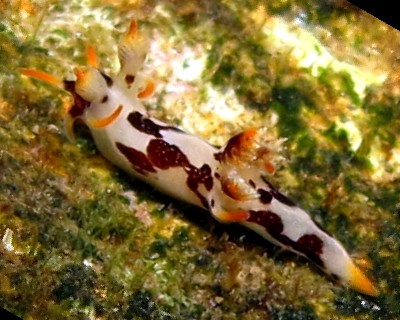
Concerning message #3426:
Dear Bill,
I think this is Trapania goslineri. I got only single specimen in intertidal rockpool below rock.
Locality: Mandavi, Ratnagiri, , 1 feet, Maharshtra, India, Arabian sea, 26 February 2010, Intertidal rockpools with lose rocks encrusted with variety of Hydroids, bryozoans and ascideans. Length: 9 mm. Photographer: Vishal Bhave.
Vishal Bhave
vishalbhave@gmail.com
Bhave, V.J., 2010 (Mar 3) Trapania goslineri? from Ratnagiri, India. [Message in] Sea Slug Forum. Australian Museum, Sydney. Available from http://www.seaslugforum.net/find/23291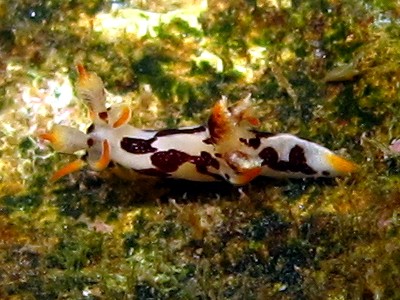
Note added 15 March 2010: Hans Bertsch does not think this is T. goslineri. See message #23350
Note added 1 June 2010: This is probably T. toddi. see message #23677.
Dear Vishal,
It certainly looks like T. goslineri from the tropical East Pacific, and the white specks on the brown patches make it almost identical in colour to another eastern Pacific species, T. darwini from the Galapagos Ids. As you will see on that Fact Sheet, I suggest these two species may be colour forms of a single species. The only difference I can see in your animal from India is the presence of some brown on the gills and rhinophores.
There are some Indo-west Pacific species which are found in the eastern Pacific, but it is quite unusual. Before we start wondering if it is a tramp species travelling around on the bottom of boats or as larvae in ballast water, we would need to look at its radula. There is always the possibility that there are two, or three, very similarly coloured species, and the radular morphology can sometimes be a good distinguishing feature.
Best wishes,
Bill Rudman
Radula of Trapania toddi from Hong Kong
March 12, 2008
From: Bill Rudman
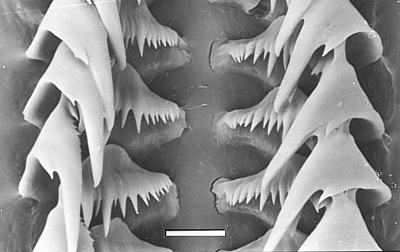
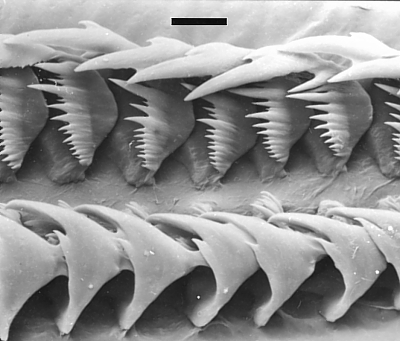
To complement today's posting of many new species of Trapania here are SEM photos showing aspects of the morphology of the radula of a specimen of Trapania toddi from Hong Kong.
SEM photos showing sections of the radular ribbon. AM C139073, Paratype. 6 April 1983, Site 6.48, Loo Fu Fong, Tolo Channel, 3-6 m, Hong Kong. SEM Photos: G. Avern. Scale = 10 µm.
- Rudman, W.B. (1987) The genus Trapania (Nudibranchia: Goniodorididae) in the Indo-West Pacific. Journal of Molluscan Studies, 53: 189-212.
Best wishes
Bill Rudman
Radula of Trapania toddi from the Red Sea
March 12, 2008
From: Bill Rudman
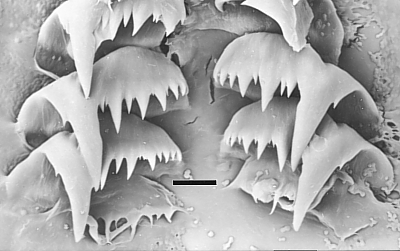
To complement today's posting of many new species of Trapania here is an SEM photo showing aspects of the morphology of the radula of specimen of Trapania toddi from the Red Sea.
SEM photos showing sections of the radular ribbon. Suakin, Red Sea, Sudan, May 1980. 3mm long alive. AM C131644. SEM Photos: G. Avern. Scale = 10 µm.
- Rudman, W.B. (1987) The genus Trapania (Nudibranchia: Goniodorididae) in the Indo-West Pacific. Journal of Molluscan Studies, 53: 189-212.
Best wishes
Bill Rudman
Trapania toddi from Sth Korea [1]
May 28, 2005
From: Dong Bum Koh
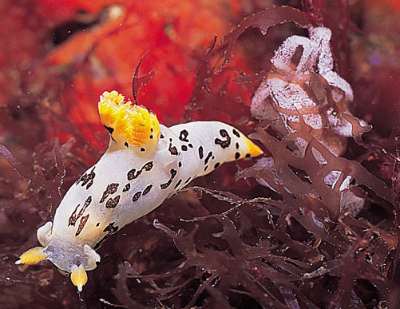
Dear Bill,
This is a photo of what I think is Trapania toddi. But I'm not sure.
Locality: Kang Reung, Kang Won Province. Sth Korea. Depth: 20 m. Aug. 2002. Photographer: Unknown. Photo Credit to Poong Deung Publishing company
Best regards,
Dong Bum Koh
drkoh@seasee.co.kr
Koh, D. B. , 2005 (May 28) Trapania toddi from Sth Korea [1]. [Message in] Sea Slug Forum. Australian Museum, Sydney. Available from http://www.seaslugforum.net/find/13883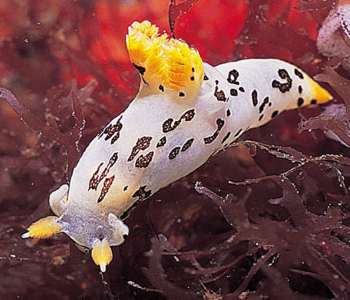
Dear Koh,
Thanks for this record of T. toddi from Sth Korea. The animals in your other message [#13884] are also this species but show a more extensive covering of brown patches. In this animal the brown patches are very small but if you look carefully you can see the little white spots in the brown which is characteristic of the colour pattern. Sometimes the white spots are closer together so the brown patch becomes just a brown network.
Best wishes,
Bill Rudman
Trapania toddi from Sth Korea [2]
May 28, 2005
From: Dong Bum Koh
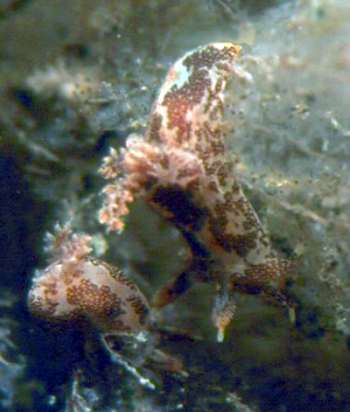
Dear Bill,
This is a photo of what I think is Trapania brunnea Rudman, 1987.
But I'm not sure.
Locality: Seogwipo. Bum islet, Jeju Island. Sth Korea. Depth: 32 m. Length: 4 mm. 13 June 2004. Rock Wall. Photographer: Dong Bum Koh
Best regards,
Dong Bum Koh
drkoh@seasee.co.kr
D. B. Koh, 2005 (May 28) Trapania toddi from Sth Korea [2]. [Message in] Sea Slug Forum. Australian Museum, Sydney. Available from http://www.seaslugforum.net/find/13884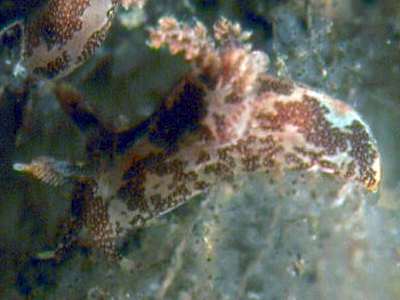
Dear Koh,
Although similar to T. brunnea, I think this is also Trapania toddi, although the brown patching is more extensive and the yellow less obvious than your other animal [message #13883]. The pattern of the brown patches on the white background, and the yellow tips to the rhinophores, foot and dorsal processes is typical of that species. Trapania brunnea usually has a background colour of dark brown and some white patches It also seems to be restricted to temperate southern Australia and northern New Zealand.
Best wishes,
Bill Rudman
Trapania toddi from The Japan Sea
July 12, 2002
From: Shigeru Hayashi
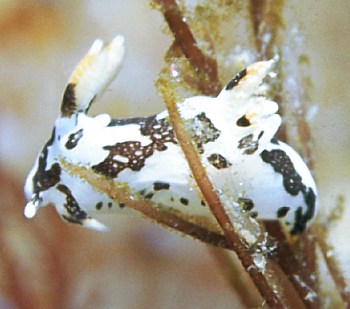
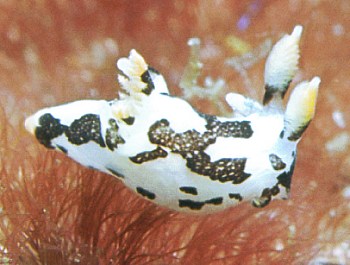
Dear Bill,
Here is an additional record of Trapania toddi from the Japan Sea. The rhinophores of this specimen can be conspicuously seen compared with the previous individual. Feeding cannot be confirmed.
Collection data: 2 March 2002, Uozu, Toyama Bay, 8mm long alive, Water temperature 11.4 deg C.
Photo: H. Hagiwara - Courtesy of the Takaoka Biological Club, Japan.
Best wishes.
Shigeru Hayashi
jr9dsx@tko.fitweb.or.jp
Hayashi, S., 2002 (Jul 12) Trapania toddi from The Japan Sea. [Message in] Sea Slug Forum. Australian Museum, Sydney. Available from http://www.seaslugforum.net/find/7449Dear Shigeru,
Additional records are always welcome.
Best wishes,
Bill Rudman
Trapania toddi from Hong Kong
January 29, 2002
From: Bill Rudman & Brian Darvell
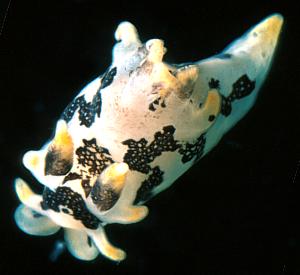
Here is some information and photos on Trapania toddi from Brian Darvell's Hong Kong collections. This species is recognized by the regularly arranged brown reticulate pattern on the translucent white background, and the yellow markings on the oral tentacles, lateral processes, rhinophores, gills and posterior tip of the foot. The largest known specimen is 6 mm long preserved.
PHOTO:
AM C139073, 6 April 1983, Site 6.48, Loo Fu Fong, Tolo Channel, 3-6 m, Hong Kong.
Hong Kong Collection Records:
AM C139073, C151182, 6 April 1983, Site 6.48, Loo Fu Fong, Tolo Channel, 3-6 m, Hong Kong.
Reference:
• Rudman, W.B. & Darvell, B.W. (1990) Opisthobranch molluscs of Hong Kong. Part 1. Goniodorididae, Onchidorididae, Triophidae, Gymnodorididae, Chromodorididae, (Nudibranchia). Asian Marine Biology, 7: 31-79
Best wishes,
Bill Rudman & Brian Darvell
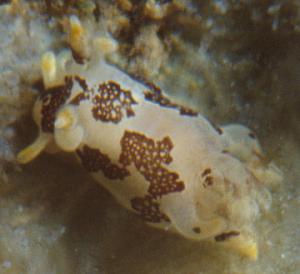
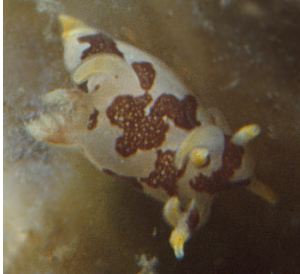
Trapania toddi feeding
January 29, 2002
From: Bill Rudman
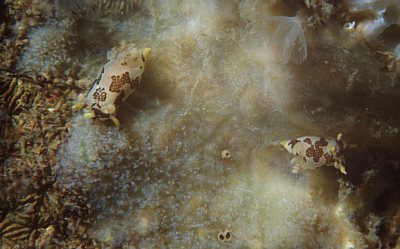
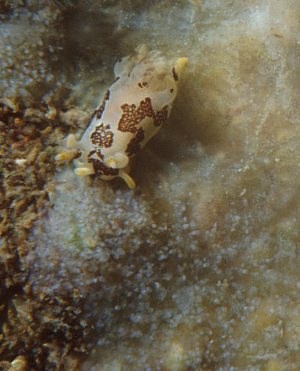
While preparing photos of Trapania toddi from Brian Darvell's Hong Kong collections I noticed this photo of Brian's of two animals on a sponge. It clearly shows parts of the sponge densely covered in growths which I am pretty sure are entoprocts and from the clear area around the nudibranchs head I thin we can be pretty sure that this is a further species feeding on entoprocts. [See Bernard Picton's message on species of Trapania feeding on entoprocts].
PHOTO:
AM C139073, C151182, 6 April 1983, Site 6.48, Loo Fu Fong, Tolo Channel, 3-6 m, Hong Kong.
Best wishes,
Bill Rudman
Range extension for Trapania toddi
April 6, 2001
From: Julie Marshall
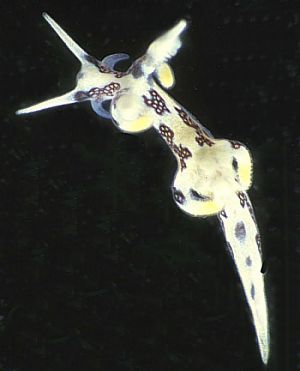
Dear Bill,
Attached is a photo of Trapania toddi which I have found on three occasions at Heron Island, all at the reef crest under coral slabs at low tide. The pictured animal was 4 mm in size and was found in January 1994.
Best wishes,
Julie Marshall
j.marshall@latrobe.edu.au
Marshall, J., 2001 (Apr 6) Range extension for Trapania toddi. [Message in] Sea Slug Forum. Australian Museum, Sydney. Available from http://www.seaslugforum.net/find/4121Dear Julie,
An interesting find. Considering its known distribution [Red Sea, Hong Kong], I guess we could have expected it to turn up in Queensland sometime, but it is certainly nice to actually find it.
Best wishes,
Bill Rudman.
Trapania japonica? from the Japan Sea
December 22, 2000
From: Shigeru Hayashi
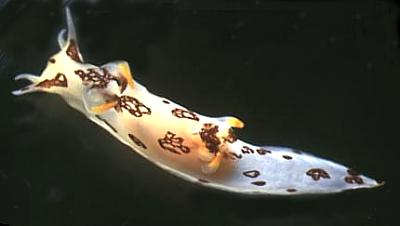
Dear Bill
I want to report the record of Trapania japonica from The Japan Sea but it lacks a decisive factor. Unfortunately the specimen died and distintegrated after photography. It was therefore not possible to dissect it and study the radula. Will it be possible to identify it as T. japonica from the photographs?
The collection data : Notojima, Toyama Bay; 1 specimen (14mm long alive), 29 October 2000.
Sincerely yours
S. Hayashi
jr9dsx@tko.fitweb.or.jp
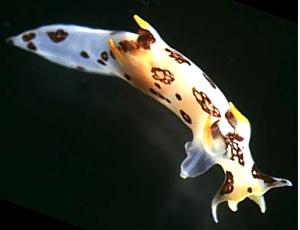
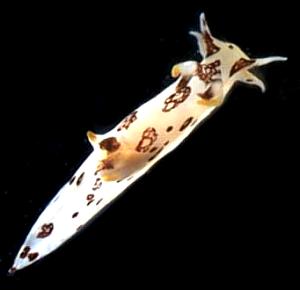
Dear Shigeru,
Thanks for the record of Trapania from Japan. I am afraid that it is not possible at this stage to confirm the identity of Trapania japonica from a photograph. It was described from a preserved animal (Baba, 1933) and on the basis of the quite distinct radula, I tentatively identified animals from Australia and Hong Kong as T. japonica. To confirm its identity it would be good to get a specimen from Mutsu Bay in Japan, or nearby, with a similar radula.
I suspect your animal is another species, Trapania toddi in which the brown spots are replaced by a brown reticulate pattern and the mantle processes are tipped with yellow rather than being completely yellow. The photo I have on the Forum of T. toddi is of a juvenile, but when I get a chance I will add a photo of an adult from Hong Kong which shows the yellow markings clearly.
The radula of T. toddi differs from T. japonica in having the cusp on the outer edge of the tooth rather than in the middle. Hopefully you will find some more specimens of this interesting animal.
Best wishes,
Bill Rudman.
